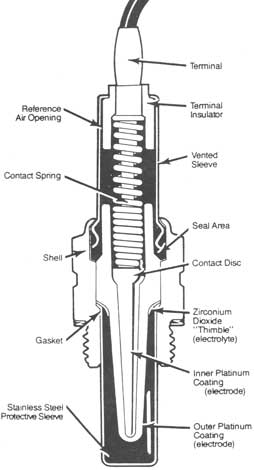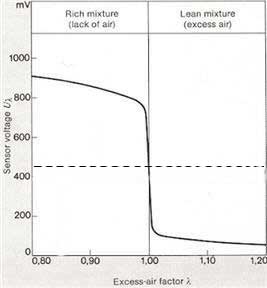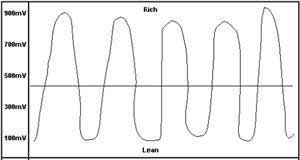Oxygen sensors (O2 sensor or Lambda sensor) have been around for a long time now and were first introduced on vehicles employing an engine management system and a three-way catalytic converter. O2 sensors are placed within the exhaust system upstream of the catalytic converter and as close to the collector as possible to take advantage of exhaust temperatures for efficiency. In " V " engines with separate bank exhausts, some may have a sensor placed in each collector bank. In some later model vehicles two O2 sensors are fitted, one upstream of the converter and one at the rear of the converter. The fuel management system uses the rear sensor to monitor converter operating efficiency by comparing the fore and aft sensor readings. Little or no change in oxygen content readings between both sides of the converter means the converter is not doing anything and this may cause the Malfunction Indicator Lamp (MIL) to come on and generate a fault code in the ECU.
|
|
The first oxygen sensors in use were a one wire configuration (left image), then improved to a two wire. Now oxygen sensors incorporate a heater element which requires additional wiring to three or four wire configurations. Early type sensors were of a zirconia type and some later types were of a titania type construction. Of the two types mentioned, each has its own distinct construction and operating method but I am only covering the zirconia type here. The sensor used in most vehicles is a voltage generating sensor. The tip of the sensor has a zirconium ceramic bulb coated on the inside and outside with porous platinum, which serve as the electrodes. Inside the bulb are two platinum electrodes. The inside of the bulb is vented through the sensor housing to the outside atmosphere. When the bulb is exposed to hot exhaust, the difference in oxygen levels across the bulb creates a voltage. The sensor will generate up to about 0.9 volts when the fuel mixture is rich and down to 0.1 volts when the mixture is lean. When the air/fuel mixture is at about 14.7:1, the sensor will generate around 0.45 volts. This is known as stoichiometric air/fuel ratio (Lambda 1) this is represented in the diagram below.
|
Open and Closed Loop.
Now might be a good time to talk about this topic. You may have heard these terms bantered around by your local mechanic but did not know what he was talking about. What he is referring to are two conditions that exist in a fuel injected engine fitted with an O2 (Lambda) sensor. Let's start with the open loop condition. From the moment you start your engine from cold the engine management system is in open loop. This means that the fuel injected into the engine is governed by preset parameters programmed into the ECU. The parameters are engine coolant temperature, air intake temperature, air mass, engine vacuum and throttle position to name the common ones. Information from these sensors are fed into the ECU and the ECU compares these to set values programmed into the ECU and then outputs the corresponding injection duration opening time according to the data in the mem-cal of the ECU. The output isn't exactly correct, however it is reasonably close and errs in the direction of slightly rich. The ECU cannot detect at this stage if the mixture is actually correct, it only knows what has been hard coded into the mem-cal and responds to the input it has received.
What if a few of the injectors were leaking or maybe the fuel pressure is down slightly or many other faults were present with the sensors. How is the ECU to know if it needs to compensate for lean or rich mixtures. The simple answer is, it can't. All early injection systems operated in open loop, although it is not referred to as such on these systems.
The next generation injection system came along that enabled feedback to the ECU of the exhaust gas to detect the excess oxygen in the exhaust composition. This feedback was made possible by the Oxygen sensor. Once the O2 sensor reaches it operating temperature (360deg C) a voltage is generated from the sensor as detailed earlier and is fed to the ECU and from this voltage the ECU can determine if the fuel needs to be altered richer or leaner. This feedback happens very quickly and constantly moves backwards and forwards (covered shortly) as the ECU constantly tries to make minor adjustments to injection time. When the oxygen sensor output is 0.45 volts the mixture is at Lambda 1. When the ECU begins to control the fuel mixture from the voltage it receives from the oxygen sensor, then it has entered closed loop. The ECU maintains closed loop while the engine is cruising, idling after cruising and light acceleration. Once you want to increase acceleration or maintain full power the system returns to open loop. This is because an air fuel ratio of Lambda 1 is too lean for power, so the system must return to its pre-programmed state. Also the system can enter closed loop much quicker when the sensor is fitted with a heating element.
|
When the engine is running in closed loop, a good sensor will produce a voltage that is constantly changing back and forth from rich to lean. The transition rate for engines with throttle-body injection (TBI) is about two or three times per second at approx 2500rpm. Engines with multiport injection are somewhat faster at five to seven times per second at the same rpm. |
|
An O2 sensor failure or a problem in the sensorís wiring circuit will prevent the system from going into closed loop causing a rich-fuel condition, increased emissions (particularly CO) and fuel consumption. The sensor is a maintanance item and as such needs to be replaced at service intervals depending on how well the management system has been operating. Oxygen Sensors should be checked and/or replaced at - 50,000 km for single and two wire sensors, 80,000 km for three or four wire heated sensors and 160,000 km for planar type sensors which are the latest and greatest. (not covered in this article)
O2 sensor performance diminishes with age as contaminants accumulate on the sensor tip and gradually reduce its ability to produce voltage. The sensor becomes sluggish and takes longer to react to oxygen changes in the exhaust causing emissions and fuel consumption to go up. The effect is most noticeable on engines with multipoint fuel injection because the fuel ratio changes more rapidly than on the throttle-body injection. The three most common causes for failure apart from age are:
- using incorrect sealants on engine gaskets (must use sensor safe silicones)
- incorrect coolant (internal coolant leaks) and
- physical damage possibly caused by excess shock during removal.


